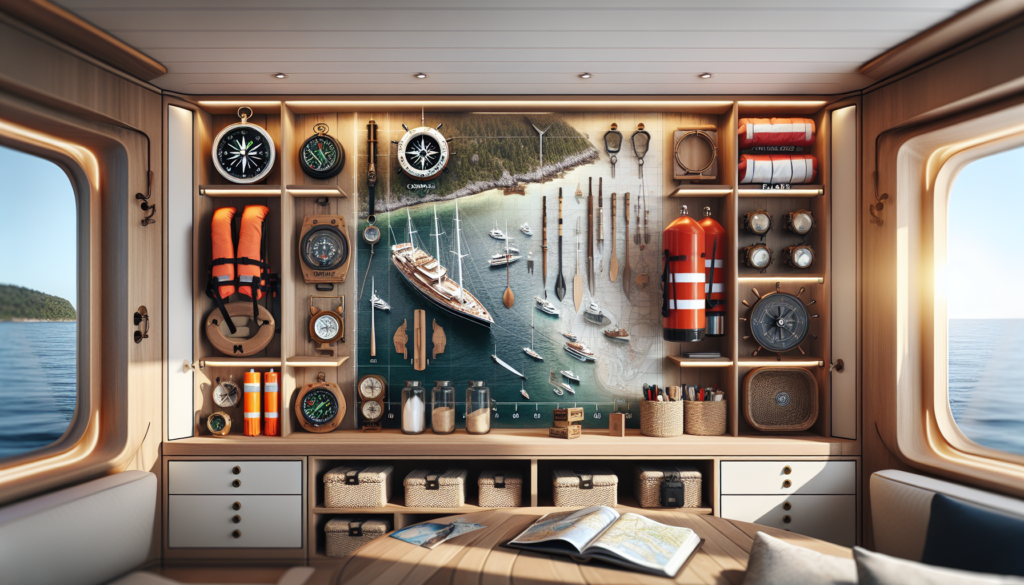If you’re a boating enthusiast, you know that maximizing storage space on your boat is crucial. Whether it’s fishing gear, life jackets, or snacks for a day on the water, having custom shelving and storage solutions can make a world of difference. In this article, we’ll explore some tips and tricks on how to add custom shelving and storage to your boat, helping you stay organized and make the most out of your boating adventures. So let’s dive in and transform your boat into a well-organized and efficient space!

Choosing the Right Shelving and Storage Options
When it comes to adding custom shelving and storage to your boat, it is essential to choose the right options that will meet your specific needs. Before diving into the installation process, there are a few factors you need to consider.
Considering the available space
The first thing you should do is assess the available space on your boat. Different types of boats have varying amounts of storage area, so it’s important to make the most of what you have. Take note of any unused or underutilized spaces that can be converted into storage areas.
Assessing your storage needs
Next, you need to determine your storage needs. Think about what items need to be stored on your boat and how much space they will require. Consider the types of items you will be storing, such as fishing gear, safety equipment, or personal belongings. This will help you identify the specific storage solutions you will require.
Determining the type of shelving or storage system
Once you have a clear understanding of your available space and storage needs, it is time to determine the type of shelving or storage system that will work best for your boat. There are various options available, including wooden shelves, pre-made storage units, custom storage solutions, and foldable shelving. Consider the pros and cons of each option and choose the one that aligns with your preferences and requirements.
Measuring and Planning for Installation
Before you begin the installation process, it is crucial to take precise measurements and plan accordingly. This will ensure a smooth and successful installation.
Taking precise measurements
To accurately measure the space where you plan to install the shelving or storage units, use a tape measure. Measure the height, width, and depth of the area to ensure the shelves or units fit correctly. Taking precise measurements will help you avoid any issues during the installation process.
Identifying suitable areas for installation
Once you have taken measurements, identify the suitable areas on your boat for installing the shelving or storage units. Consider factors such as accessibility, weight distribution, and convenience. Optimal locations for installation include areas with underutilized space or areas near your most frequently used items.
Sketching out the layout
To ensure a well-organized and functional storage system, sketch out the layout of your shelving and storage units. This will help you visualize the arrangement and ensure that everything fits together seamlessly. Take note of any customization or modifications needed to accommodate specific items or spaces.
Materials and Tools Required
Before you can start building or installing your custom shelving and storage, you need to gather the necessary materials and tools.
Choosing marine-grade materials
Since your boat will be exposed to water and high humidity levels, it is essential to choose materials that are resistant to moisture and corrosion. Opt for marine-grade materials such as stainless steel, treated wood, or PVC for the shelving units. These materials are specifically designed to withstand the harsh marine environment and ensure longevity.
Gathering necessary tools for installation
To complete the installation process, you will need a set of basic tools. Some essential tools to have on hand include a drill, screws, screwdriver, measuring tape, level, saw, and sandpaper. These tools will help you assemble, install, and make any necessary adjustments to your custom shelving and storage systems.
Considering additional accessories
Depending on your storage needs, you may want to consider adding additional accessories to enhance functionality. These accessories could include hooks, racks, holders, or dividers. These small additions can make a significant difference in maximizing your storage space and keeping everything organized.
Building Basic Wooden Shelves
If you prefer a more hands-on approach and have some woodworking skills, building basic wooden shelves can be a great option for adding custom storage to your boat. Here’s how you can do it:
Preparing the wood materials
Start by selecting the appropriate wood materials for your shelves. Opt for lightweight yet sturdy wood that is resistant to moisture and corrosion. Consider using treated or marine-grade plywood. Cut the wood to the desired sizes for your shelves using a saw.
Cutting the shelves to size
Using your measurements from earlier, mark the dimensions on the wood panels and cut them to size accordingly. Take your time to ensure accuracy and precision in your cuts. Sand down any rough edges to create a smooth surface.
Assembling the shelves
Once you have cut the shelves to size, it’s time to assemble them. Lay out the pieces and use screws or nails to attach them together securely. Make sure the shelves are level and sturdy. If desired, you can add additional reinforcement by attaching brackets or corner supports.

Installing Pre-made Shelving and Storage Units
If you prefer a quicker and easier option, consider utilizing pre-made shelving and storage units specifically designed for boats. Here are the steps to follow for a successful installation:
Exploring pre-made options available
Research various pre-made shelving and storage options specifically designed for boats. Look for units that match your requirements in terms of size, style, and functionality. Take note of any features that could enhance your storage needs, such as adjustable shelves or modular designs.
Determining the best position for installation
Carefully consider the best position for installing the pre-made shelving and storage units. Take into account factors such as weight distribution, accessibility, and convenience. Make sure the units do not interfere with any existing equipment or obstruct movement around the boat.
Securing the units properly
Follow the manufacturer’s instructions for securing the pre-made shelving and storage units properly. Use the recommended fasteners and mounting hardware to ensure a secure and stable installation. Pay attention to weight limits and distribute the weight evenly across the units. Double-check the stability and make any necessary adjustments.
Creating Custom Storage Solutions
For those with specific storage needs or unique boat layouts, creating custom storage solutions can be the perfect option. Here’s how you can go about it:
Designing compartments and dividers
Consider your specific storage needs and design compartments and dividers to meet them. Assess your items and determine the best way to categorize and group them. Divide your storage space into sections to ensure easy access and organization.
Utilizing wall space effectively
Utilize the wall space on your boat to create additional storage areas. Install wall-mounted shelves, racks, or compartments to maximize the use of vertical space. Consider your boat’s layout and ensure that the wall-mounted storage does not interfere with any equipment or cause any safety hazards.
Building overhead storage
Another effective way to maximize storage space is by building overhead storage. Utilize the area above seating or sleeping areas to create compartments or cabinets. These overhead storage solutions can be a great way to store items that are not frequently used but need to be easily accessible.

Adding Hooks, Racks, and Holders
Hooks, racks, and holders are excellent additions to your custom storage solutions as they provide convenient ways to hang and secure items. Here’s what you need to know:
Choosing the appropriate types of hooks and racks
Consider your specific storage needs and select the appropriate types of hooks and racks. For hanging items such as coats or towels, opt for sturdy hooks. Racks can be used for holding fishing rods, tools, or other elongated items. Ensure that the hooks and racks you choose are designed to withstand the marine environment.
Installing hooks for hanging items
Determine the optimal positions for installing hooks based on the items you plan to hang. Mark the positions on the wall or inside cabinets, and secure the hooks using the appropriate screws or fasteners. Make sure the hooks are placed securely and can support the weight of the items.
Mounting holders for fishing rods or tools
If you have fishing rods, tools, or other long items that need to be stored securely, consider mounting holders. Choose holders that are designed specifically for boats and can withstand the movement and vibrations experienced on the water. Mount the holders securely in locations that are easily accessible but out of the way.
Utilizing Under-Seat Storage
One often-overlooked storage area on boats is under the seats. Here’s how you can make use of this space effectively:
Assessing the potential storage space under the seats
Carefully assess the available space under the seats on your boat. Measure the length, width, and depth of the area to determine what can be stored. Take into consideration any existing wiring, machinery, or safety equipment that might be present under the seats.
Building or purchasing under-seat storage solutions
Once you have assessed the space, you can either build custom under-seat storage solutions or purchase pre-made ones. If you choose to build, use marine-grade materials and follow the same principles as building basic wooden shelves. Alternatively, there are pre-made under-seat storage bins or compartments designed specifically for boat use that can be easily installed.
Securing the storage units in place
Whether you build your own under-seat storage or purchase pre-made solutions, it is crucial to secure them in place properly. Use screws, hinges, or brackets to attach the storage units securely to the boat. Double-check for stability and make any necessary adjustments to ensure that the storage units do not shift or move while the boat is in motion.

Maximizing Space with Foldable Options
Foldable shelving and storage options are a fantastic way to maximize space on your boat while maintaining flexibility. Here’s what you need to know:
Exploring foldable shelving and storage options
Research different types of foldable shelving and storage options available for boats. Look for designs that can be easily collapsed or folded when not in use, allowing you to reclaim valuable space. Folding tables or workstations can be particularly useful when you need temporary surfaces for activities such as cooking or working.
Creating foldable tables or workstations
If you have some woodworking skills, you can create your own foldable tables or workstations to suit your specific needs. Use marine-grade materials that are lightweight yet sturdy. Follow step-by-step instructions or find plans online to guide you through the construction process. Ensure proper installation and stability by using hinges, locks, or other folding mechanisms.
Ensuring proper installation and stability
Whether you opt for pre-made foldable shelving or DIY projects, it is vital to ensure that they are installed properly and provide sufficient stability when in use. Follow the manufacturer’s instructions if using pre-made options, or double-check your construction techniques if building your own. Make sure all folding mechanisms are secure and functional to prevent accidents or damage to your belongings.
Maintaining and Organizing Your Custom Storage
Once you have installed your custom shelving and storage solutions, it is crucial to maintain them properly and keep everything organized. Here’s how:
Regular cleaning and inspection
Make it a habit to clean and inspect your custom storage regularly. Remove any dirt, dust, or debris that may have accumulated. Check for any signs of damage or wear and tear, and address them promptly. Regular cleaning and inspection will help extend the lifespan of your storage systems and ensure they remain functional.
Implementing effective organization systems
To keep your storage space organized, consider implementing effective organization systems. Use bins, trays, or dividers to categorize and separate different types of items. Labeling the storage compartments can also help you find what you need quickly and efficiently. Take the time to arrange items neatly after each use to maintain an organized and clutter-free environment.
Labeling and categorizing stored items
One of the key aspects of maintaining an organized storage system is labeling and categorizing stored items. Use waterproof labels or tags to identify the contents of each storage compartment. Group similar items together to make it easier to locate them when needed. Regularly review and update your labels and categorization system to keep everything in order.
In conclusion, adding custom shelving and storage to your boat can greatly enhance its functionality and organization. By carefully considering your available space, storage needs, and the type of shelving or storage system that suits you best, you can create a customized solution that optimizes your boat’s storage capabilities. Whether you choose to build or install pre-made options, ensure proper measurements, planning, and secure installation for a successful outcome. Maintain and organize your custom storage regularly to keep everything in order and make the most of your boating experience. Happy organizing!


